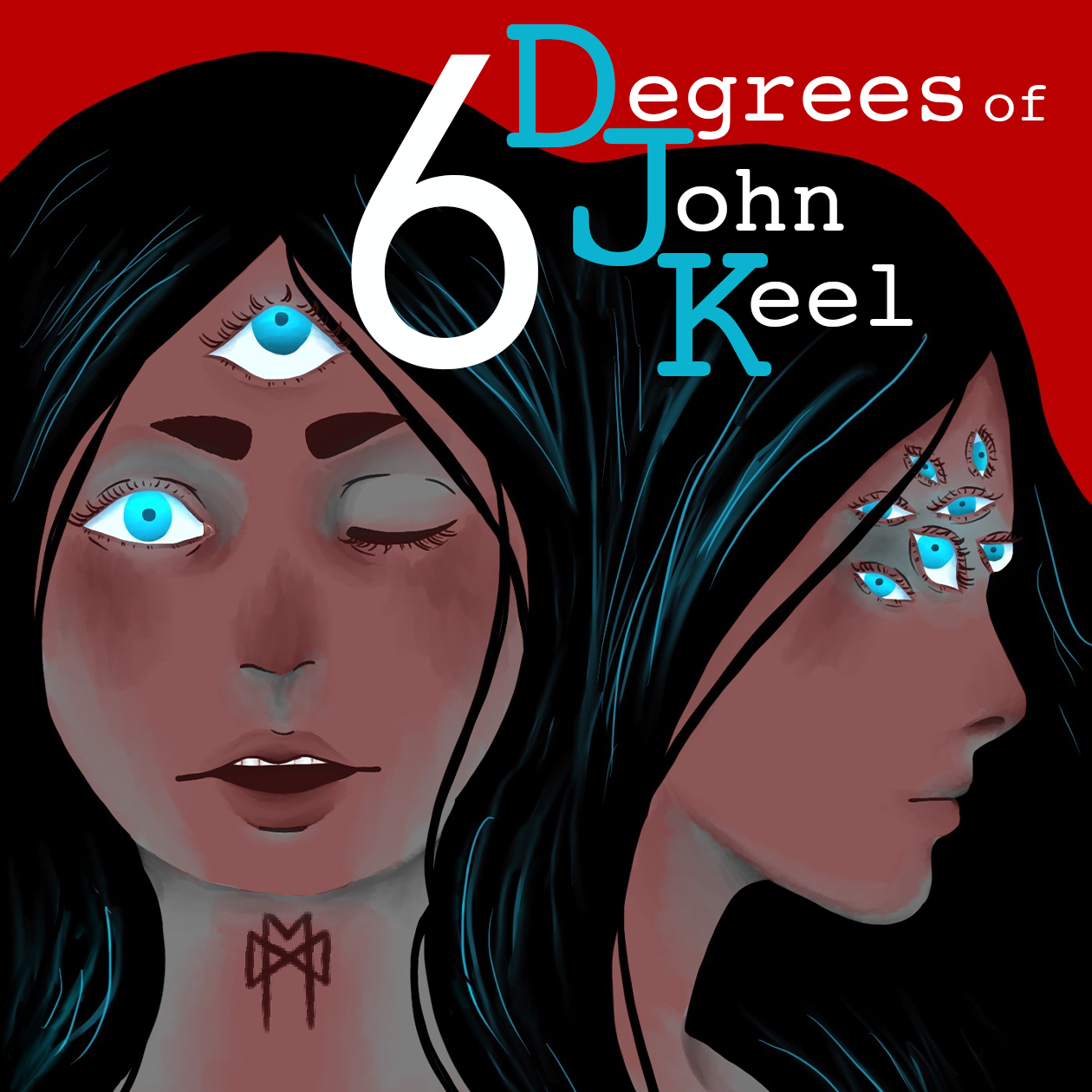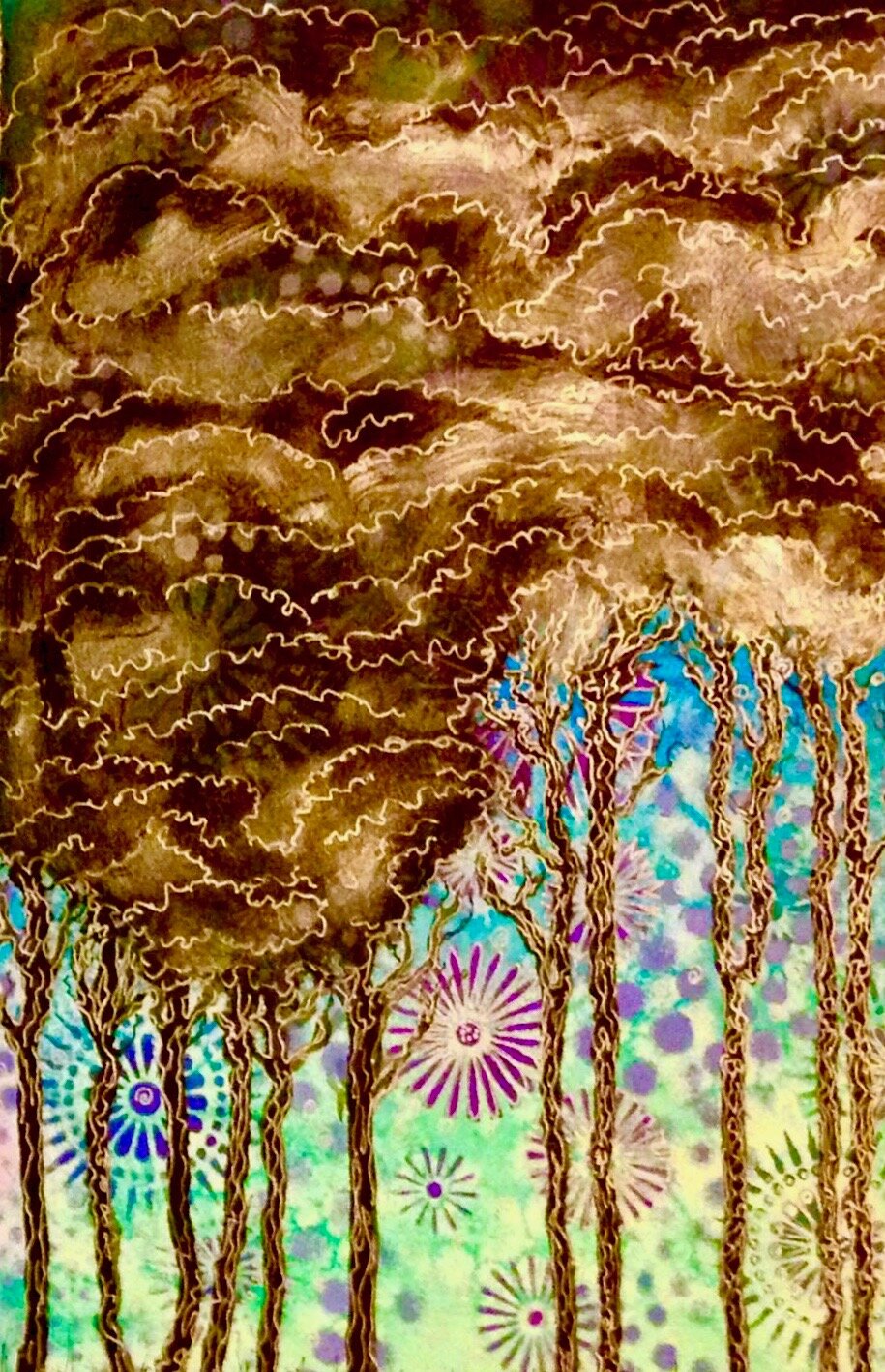Don’t Follow The Lights
“Lights in the Trees”—Mixed Media, Barbara Fisher
“Her voice was so low that at first he could not make out what she said. Then he made it out. She was saying that she thought she could get well again if children believed in fairies.
Peter flung out his arms. There were no children there, and it was night time; but he addressed all who might be dreaming of the Neverland, and who were therefore nearer to him than you think: boys and girls in their nighties, and naked papooses in their baskets hung from trees.
”Do you believe?” he cried.
Tink sat up in bed almost briskly to listen to her fate.
She fancied she heard answers in the affirmative, and then again she wasn’t sure.
”What do you think?” she asked Peter.
”If you believe,” he shouted to them, “clap your hands; don’t let Tink die.”
Like many children, I loved Peter Pan.
Unlike some children, I didn’t just watch the Disney movie or the play, I read the book. I read it because I loved to read, and because I very much DID believe in fairies. I didn’t just believe in them because I liked the IDEA of them-I had SEEN them with my own eyes. I also read it because my mother wanted me to understand something very important about fairies. Something that the Disney movie downplayed, sanitized, and ignored.
Fairies are assholes sometimes.
Tinkerbell is a good case study, so we will start there. Tink in the book and the movie is jealous, conniving, quick to anger, and uses trickery to try and get her rival Wendy killed. She is also enchanting, beautiful, loyal (at times), and uses her magic to help the Lost Boys and Peter Pan. Her pixie dust lets them fly, she is loyal to Peter and helps him pull off his tricks, and helps steal children away. All of these things are par for the course of fairies in lore and legend. I also find it very interesting that belief is what brings her back to life-though in the book you get the sense that this is a game to her, that she may not actually be in mortal peril. Or perhaps that is just me, since I learned at around the age of three to be suspicious of fairies.
Why did I learn that? Well, when I was that age my mother lived in what we call “The Falling Down The Hill House.” It was out in the countryside of Athens, Ohio, surrounded by woods and fields, and had an apple orchard beside it.
It was a really fun place to be as a little kid-and it was also home to what we considered fairies. There were little many-colored light globes that would show up at night, around the house-and sometimes inside. We’d hear singing in the woods. The path that led to the forest by the house would ripple and move occasionally-as I discovered the one time I disobeyed my mother and made a beeline for it.
I never did that again.
I remember stringing silver bells in the trees, and leaving out milk for the fairies. I also remember the rules I followed.
I was not to go into the woods alone-ever. I was not to follow any lights I saw-ever. I was not to follow the singing-and if I heard my name called I was to ignore it and go to my mother or my stepfather IMMEDIATELY. If I was offered food or drink by a stranger who came out of the woods I was to ignore it and go find my parents. I would turn my coat before going into the woods every time. I was to be on the porch by dusk No Matter What. Always ask and thank if you pick berries or flowers. Don’t injure a living tree. Don’t step in a faerie ring, or dance to the music I might hear. Don’t call them fairies-call the The Good People, or the Folk.
My mother carried iron on our walks in the woods, and rarely let go of my hand. Her cat who normally hissed at me and wouldn’t play with me slept on the bed with me each night, and would leap onto the windowsill by the bed if the lights came too close, hissing and growling to drive them away.
Now, several of these are perfectly good, and normal rules to follow if you are a little kid. They are pretty much the same rules you follow so you don’t get lost, hurt, or kidnapped. And my mother mostly played them off like that. But some of them were specific to the things that lived in the woods-things that I saw and heard and knew were real.
When I started asking why we did these things, since fairies were good she explained that they were neither good nor bad, but instead were mercurial by nature. They could be good, bad, indifferent, or both good and bad, depending on the day.
They were not quite like Tinkerbell; some were very large, and they could take different shapes. They were dangerous or benign by turns, and the land we were on belonged to them. It was important to give them respect, and to follow the rules, since rules were important to them, and rules could keep us from giving offense. She never quite said out loud “You are a pretty little golden haired child and they might steal you.” I didn’t figure that part out until I was much older, and my family had moved to a different state.
I kept learning about fairies after that: fairy tales, Kathrine Briggs, and Brian Froud became big favorites. I still love all of those things. I learned several folk songs-Tam Lin was a favorite of mine and I sing it pretty well. I absorbed faerie lore and legend, firmly knowing that they were real. I also kept seeing them.
When I was around eight years old, my father and I lived in a house with an apple tree in the backyard. I started seeing the same lights in the tree that I saw in the woods by The Falling Down The Hill House. Orange, white, blue, green, red and purple soft globes, about the size of a small apple would dance in the tree each night. I also began hearing flutes and drums outside my window. They were either Native flute and drumming, or more Celtic sounding, or a combination of both musical styles.
This was in the middle of Charleston, WV and I didn’t understand why they came to the middle of a city when they were things that belonged in the wilderness. To this day I think it was the presence of the apple tree, and myself that drew them.
That has continued, off and on, to this day.
I’ve seen other things too, other lights and sometimes creatures. I still follow the rules-and when others have been with me and we’ve seen something I tell them “don’t follow the lights”. I turn my coat before I enter the wilderness, because once I didn’t and I was pixie-led. I keep iron by the door, and put out cider on important holidays. I respect that they are real-and I respect the rules.
I have almost never been afraid of them-but I am cautious. They are a little bit like Tink: they are changeable, can be vengeful, and are dazzling. They are cruel and kind in equal measure, and they do not play their games with humans fairly. Those are all things I’ve learned over the years.
I learned a lot from my mother, and more from legends and lore.
But I have never learned the answers to some of my questions.
I don’t know why I see them. I don’t know what exactly they are, or what they want, or why they come as fairies. I suspect they are the same basic thing as UFO occupants, I wonder if some of the Missing 411 cases have been pixie-led, or stolen, or offended them. I think about how much of faerie lore parallels UFO lore (and I call it lore because it is a new mythos now), and how the dead appear in company with the faeries, and so does Bigfoot!
I think about the other legends I grew up with from my grandfather-the Little People of Native legends that act like the Little People from Ireland. It’s all mixed together, and I think it all does connect somehow.
But I don’t know the answers, or the truth about any of that. I just know to be cautious and respectful, and that I’m seeing something and it consistently looks and acts like fairies do.
So when I’m asked “Do you believe in faeries?” I always answer “No, I don’t have to believe in them-I’ve seen them all my life.”

